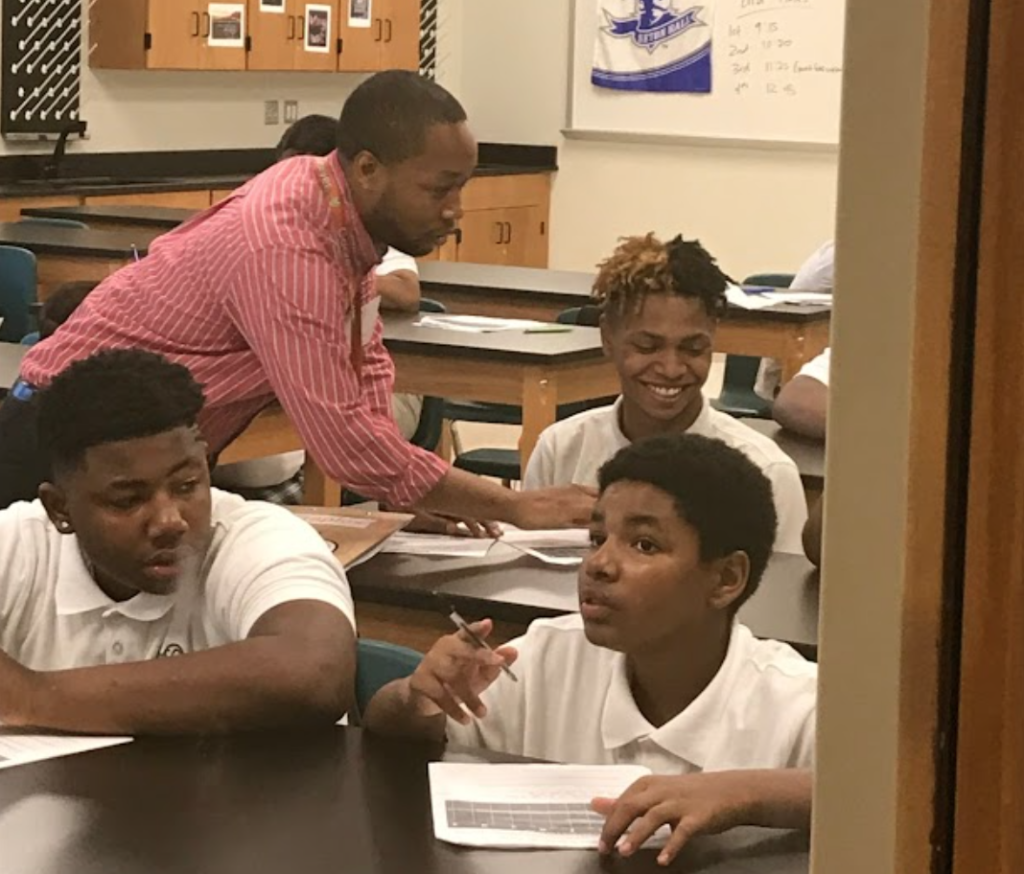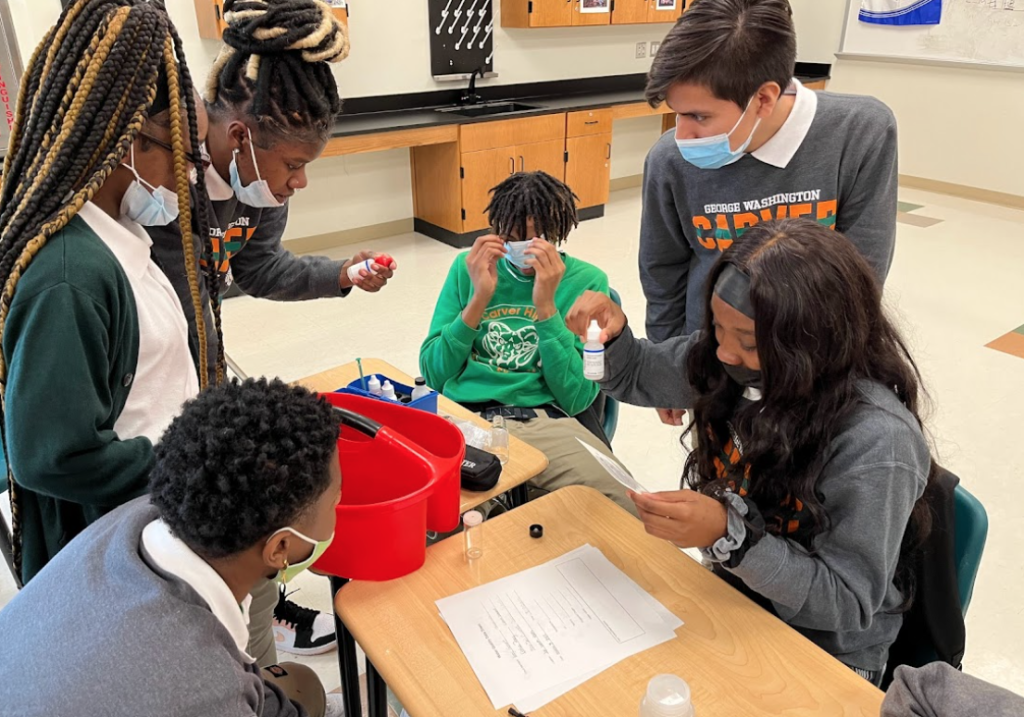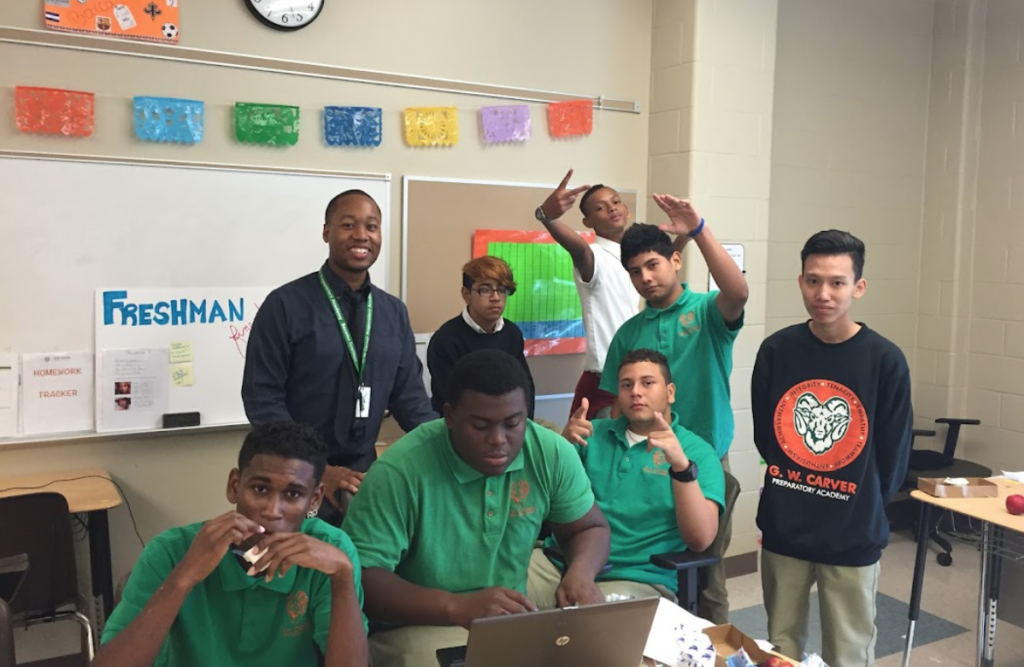
Empathy, Rigor, and Growth in Daimont Staples’ Classroom
This is the latest piece in NSNO’s series, “The Future is Bright.” We are profiling incredible educators from across our community. They are helping our students build brighter futures through the work they do each day, and their leadership creates a brighter future for our schools and our city.
Many of these educators are connected through programs NSNO leads for:
- classroom teachers (The New Orleans Teacher Community),
- current and soon-to-be principals (The Principal Collaborative and the Novice Leader Academy), and
- current and aspiring system-level leaders (E3 Fellowship).
Some share a school building, a network, or a mentor. All of them are united in their purpose to give our students the best possible education, and in so doing, build a brighter future for our children and for us all.
Today, we profile Daimont Staples, teacher at G.W. Carver High School, a Collegiate Academies School.
“I try to lead with empathy,” says Daimont Staples, who teaches freshman environmental science at G.W. Carver High School. He wants his class to be rigorous, warm, and joyful.
“I just want to be a constant for them in their life,” he explains. “So they know, when I come to this class, I’m gonna get met with a great lesson, but also someone who cares about me.”
Since the start of his career, Staples has had strong relationships with his students, but his lessons weren’t always making the impact he wanted. When he began as a 22-year-old teacher in Baton Rouge, Staples taught seniors who were just a few years younger than him. They were around his sister’s age, and they felt more like siblings to him than students.
“So I had great relationships in terms of like, buddy-buddy, an almost mentor kind of relationship,” he explains. “But I didn’t leverage those relationships to push them academically, which I regret,” he says.

Eventually, Staples moved to New Orleans and began working at Carver, where he received professional development that allowed him to practice, in and outside of class, at getting the balance right. He already had the academic background for his job from studying science in college. He easily built rapport with students. He needed to merge these strengths.
“Fortunately, Carver gives a lot of coaching and a lot of feedback to people,” he explains. “And so it was beneficial for me to get that piece of the teaching persona down…forming the right relationships, and leveraging those relationships.”

He says that he’s strict, particularly at the start of the year, but he’s also understanding. He says that if a student has had their head down on their desk, for instance, he wouldn’t simply demand that they pick it up.
“I’m genuinely asking, ‘Hey, is everything okay?’ And then they’ll either tell me, or they won’t. I just try to work with what they give me. And if they won’t respond, then I’ll suggest things like, ‘Hey, do you want to check in with the dean? You want to get some water? Do you want to go to the nurse?’”
He says students don’t always engage right away, but often, all they need is a break in the hall, two minutes to chat with another adult, or a chance to share how they’re feeling.
Through all this, Staples has built a classroom where students can feel cared for and ready to learn.
In a 2020 video that Collegiate Academies (the charter network that Carver is a part of) made celebrating Staples, freshman Ashiria G. had a clear review for Staples’ class.
“It gets you in the joy,” she said, “so you want to work more and learn more.”
This is important; Staples’ class is rigorous. He weaves in reading skills, writing skills, and the ability to prepare and give presentations. This year, he had students focus on researching a species in a specific biome, thinking as civic and environmental engineers, and then building a housing community that minimized human impact.
One group of students called their project “100 tops,” and envisioned a treehouse community above their biome, a rainforest with endangered monkeys. Their plan included incentives for veterinarians to live in the tree houses who could care for the monkeys.
“They weren’t just thinking about the space, but who they wanted in that space and why, so we could also further benefit the environment. That was a really cool one,” Staples says.

Staples sustains the hard work of creating a class like this in a number of ways. His faith and his family play a large role in his life. He has clear, practiced systems of grading, planning, and preparing his materials that save him time and effort. He also finds balance, knowing that sometimes, he needs to set boundaries in order to be the educator, parent, and person he wants to be.
“At the beginning,” of his career, he says, “I’d say yes to everything. I’d be a part of this committee, stay after school for that meeting.”
Now, he picks the additional obligations that matter the most to him, and he makes sure anything after school doesn’t conflict with picking his children up from daycare. He inquires about compensation when obligations are significant and outside of school hours. If he has to say no to something, he shares a next step he can take when he’s able. By both giving so much to his school and preserving his energy, Staples offers a model to other teachers about work-life balance.
Staples is anchored by the Carver campus values, too. One of those values is enthusiasm, which the school defines as “We choose to be positive. This positivity keeps us strong.” Staples says this resonates deeply with him. Even when things get tough, he makes a conscious choice to find a bright side.

“You can find the joy in anything you’re doing,” he says. “I feel like you can find a silver lining to anything if you look hard enough.”
It’s not hard for him to find joy in the community of Carver, though.
“I really love the community aspect of it. It’s a legacy school for so many families, where you go out in the neighborhood, and you’re wearing your Carver lanyard or your Carver T-shirt and people will start asking, ‘Oh, you went to Carver?’ And I’m like, ‘I hate to disappoint, I didn’t go there.’ But they still get super excited that I teach there. It just feels like you’re a part of something bigger, because of the alumni base that’s so strong here.”
“I’ve gotten to see like, four sets of siblings. I think there’s like two families where I’ve taught all four of the kids, which is cool. And they’re like, ‘oh, yeah, my brother’s coming next year.’ It’s just so cool to be a part of something like this.”
He’s grateful for the sense of home it provides. Staples’ family was in the military growing up, so they moved around a lot.
“Geographical stability is not something that I’m used to, but being here for eight years now, I’m like, ‘Oh, I have been here a while.’ Kids are like, ‘Oh, you might know my cousin.’ I’m like, ‘I probably do.’”
And he’s looking forward to teaching them next year.
